AMD Ryzen 5 2600 CPU Review: Efficient And Affordable
Why you can trust Tom's Hardware
Final Analysis
Much like AMD's attractive Ryzen 5 2600X, the Ryzen 5 2600 proves to be a well-rounded processor that sports many of the same selling points. It's a little bit slower right out of the box, but the 2600 also costs less and boasts a 30W-lower TDP. Similar to the Ryzen 7 2700X versus Ryzen 7 2700 story, you trade a bit of speed for a slightly lower price and a little less heat. They're different tools optimized for different applications. It just so happens that most enthusiasts favor higher benchmark results over a $20 savings or a bit less power consumption.
In that vein, the charts below plot performance using average frame rates and a geometric mean of the 99th percentile frame times, which we then convert into a FPS measurement. We also include price-to-performance charts that get split up to include CPUs-only and extra platform costs. For the models that don't come with a bundled cooler, we add an extra $25 for a basic heat sink. We also add $20 if overclocking requires a more expensive motherboard (as is the case for Z370).
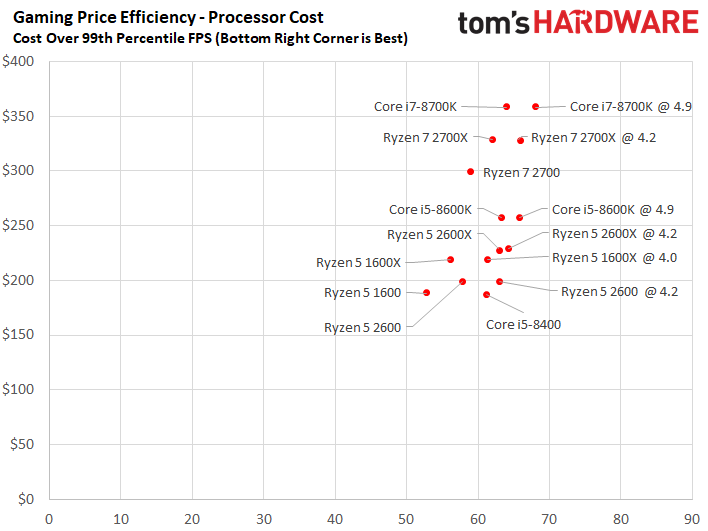
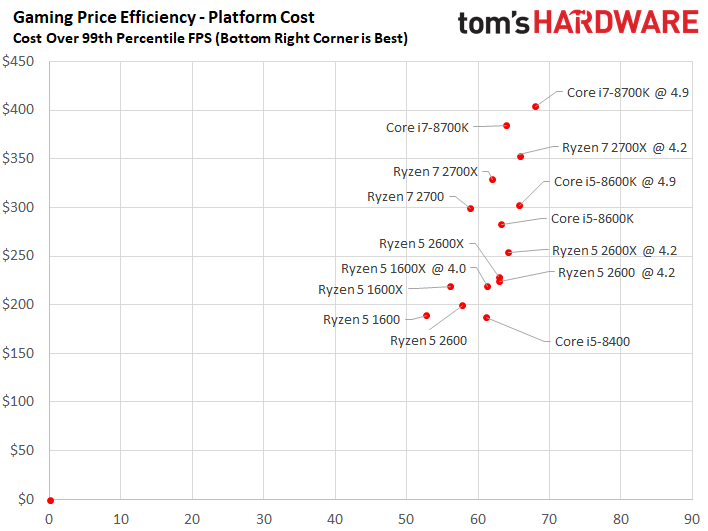
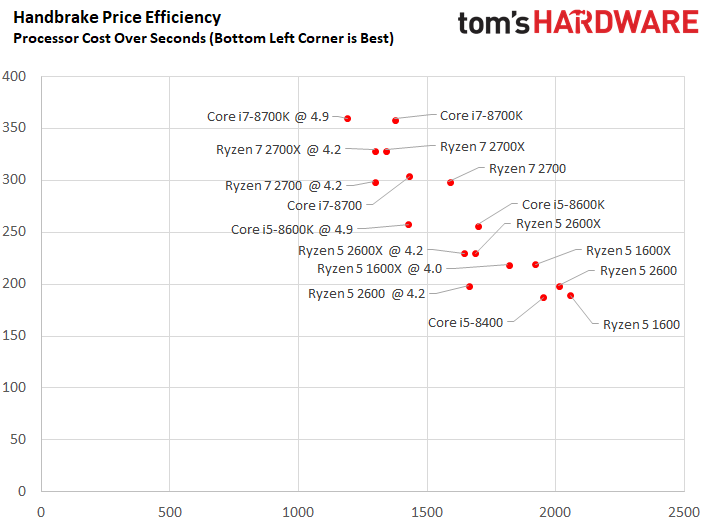
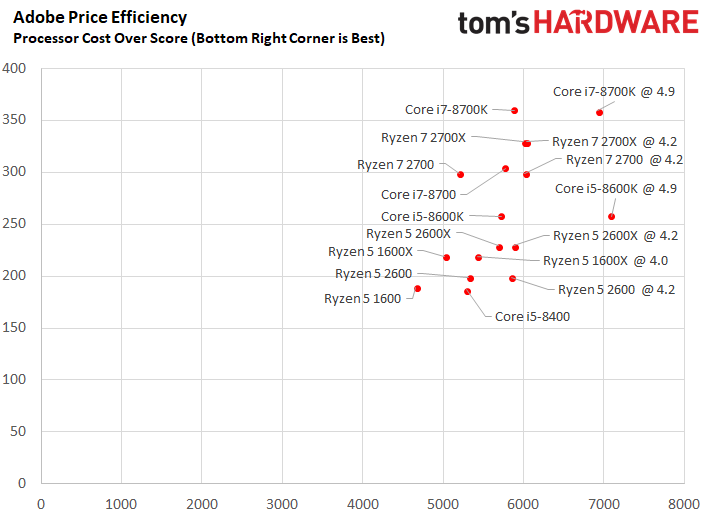
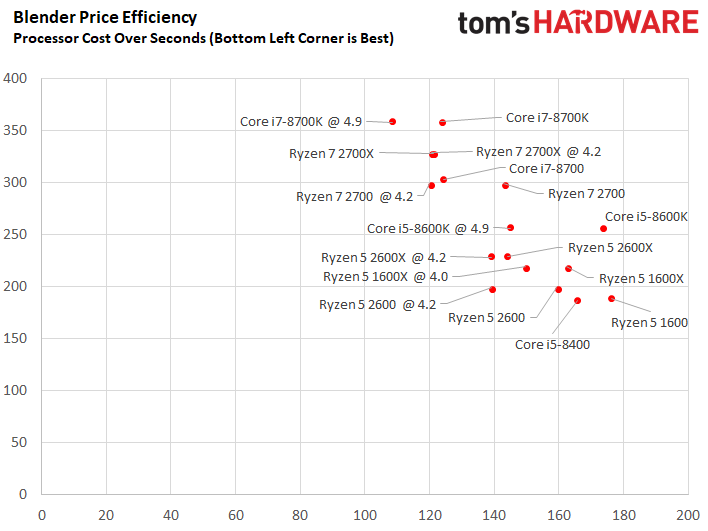
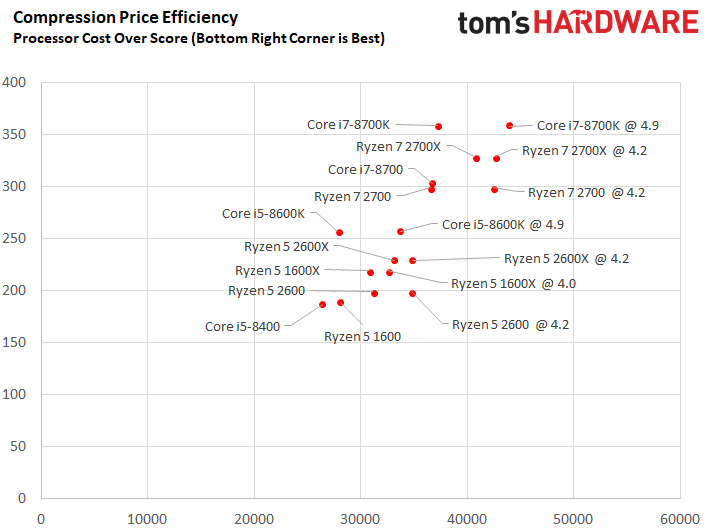
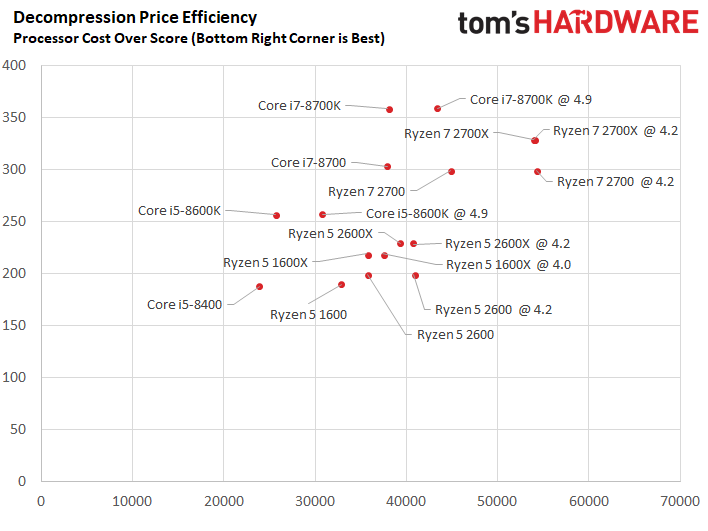
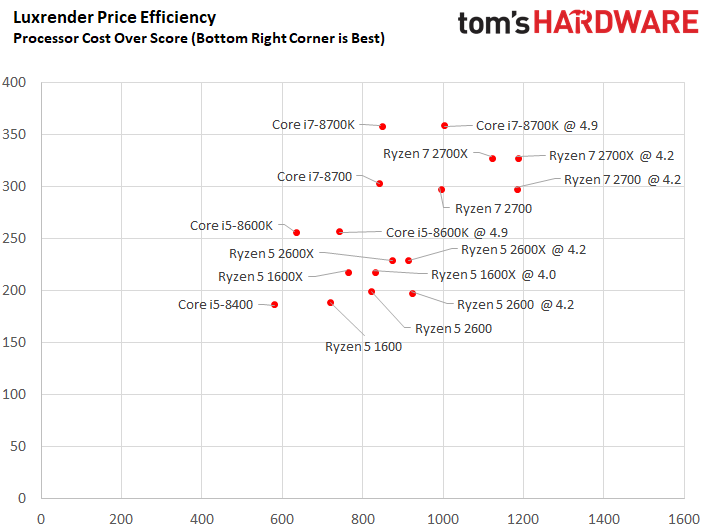
As our benchmark results suggested, Ryzen 5 2600's overclocked gaming performance is very competitive with a tuned Ryzen 5 2600X, both complemented by GeForce GTX 1080. The 2600 also fares well against Intel's Core i5-8600K, which doesn't come with a thermal solution, requires a Z-series motherboard for overclocking, and still sells for almost $70 more than the AMD chip. If you plan on overclocking, the Core i5-8600K does provide higher frame rates than any other Ryzen 5/Core i5 CPUs. But as you push higher resolutions and more demanding detail settings, the differences between processors shrink.
Intel's Core i5-8400, the least-expensive model we tested, is an impressive alternative for gaming. Like the Ryzen 5 2600, it comes with a bundled cooler and drops into value-oriented motherboards. As a result, it's priced somewhat similarly. The Core i5-8400 is our favorite choice for gamers on a budget. Although AMD's Ryzen 5 2600 can be faster after overclocking, you'll have to buy a bigger thermal solution to get there.
While we favor the Core i5-8400 for entertainment, AMD's Ryzen 5 2600 earns its praise in our application suite. Intel does maintain a performance advantage in lightly-threaded tasks. But the Ryzen chip is still competitive across those workloads. Moreover, Ryzen 5 2600's ability to execute 12 threads concurrently helps propel it to victory in more heavily-threaded benchmarks. If you do a lot of video and image processing, rendering, or game streaming, Ryzen 5 2600 should be at the top of your list in this price range.
With its Ryzen 2000-series, AMD eliminated much of our justification for stepping down to non-X models. The Ryzen 5 2600 we tested today isn't much cheaper, and it doesn't have a monopoly on bundled heat sink/fan combos. Some enthusiasts will favor the lower-end chip's 65W TDP. However, we'd rather spend an extra $20 on a Ryzen 5 2600X, deal with the 95W TDP, and enjoy its additional performance. After all, overclocking the 2600 to compensate for its lower base and boost frequencies requires splurging on a bigger thermal solution. Otherwise, you'll find yourself stuck around 4 GHz.
On the bright side, Ryzen 5 2600 is a big step up compared to the previous-generation Ryzen 5 1600. Its 6C/12T configuration at 65W is crazy-impressive for compact/low-power workstations, and we have to love all of the avaialable compute performance at a $200 price point.
Get Tom's Hardware's best news and in-depth reviews, straight to your inbox.
MORE: Best CPUs
MORE: Intel & AMD Processor Hierarchy
MORE: All CPUs Content

Paul Alcorn is the Editor-in-Chief for Tom's Hardware US. He also writes news and reviews on CPUs, storage, and enterprise hardware.
-
joeblowsmynose Really grasping at straws to come up with some cons, eh? "needs better than stock cooler for serious overclocking", "slower than a faster, more expensive CPU", lol. Those cons apply to ever CPU ever made.Reply -
Gillerer Now I know you want to use 1080p in order to get differences between CPUs and not be GPU limited. The problem is, those differences are therefore artificially inflated compared to some enthusiast gamers' hardware.Reply
It'd be nice to have one middle-of-the-road (in terms of GPU/CPU-boundness) game benchmarked in 1440p and 4k, too, as a sort of sanity check. If the differences diminish to rounding error territory, people looking to game in those resolutions with good settings might be better off getting a "good enough" CPU and putting all extra money towards the GPU.
Not only that, if there actually *was* a distinct advangage to getting the best IPC Intel mainstream processor for high-res, high-settings gaming, finding that out would be interesting. -
Blytz I chucked a basic corsair liquid cooler on my 1600X and it runs all cores @ 4.0 I hope the clock for clock is worth the upgrade for those making that stepReply -
1_rick I did the same thing (except I used an NZXT AIO) with the same results. It seems like a 4.2 OC means the 2600 isn't a worthwhile upgrade from the 1600X, but that's what I expected.Reply -
Giroro Right now the price difference between the 2600x and 2600 is $229 vs $189 , so a $40 difference.Reply -
theyeti87 I would love to know whether or not the Indium (I) Iodide 99.999% anhydrous beads that I package for Global Foundries at work is used for the solder in these chips.Reply -
Dugimodo I'm not sure if it does but I think the 8400 needs to include a basic cooler in the cost analysis after seeing several reviews that show it thermal throttles on stock cooling and loses up to 20% performance depending on load and case cooling etc. These charts make it look better than the 2600 when in reality the difference may be almost nothing. Not that I'm buying either :) too much of a performance junkie for that.Reply -
derekullo Reply21009625 said:Really grasping at straws to come up with some cons, eh? "needs better than stock cooler for serious overclocking", "slower than a faster, more expensive CPU", lol. Those cons apply to ever CPU ever made.
On the flipside the last con "Only $20 cheaper than 95W Ryzen 5 2600X" does make a lot of sense.
For only $20 you get noticeably better performance with "you may even say because" a much better cooler.
Even if I was building a computer for my grandmother who only wanted to use it to do Facebook and free casino games, I'd still go with the 2600x
-
derekullo Reply21011262 said:I think for Granny I'd go the 2400G and save on a graphics card myself.
True, but between the 2600s I'd choose the X.